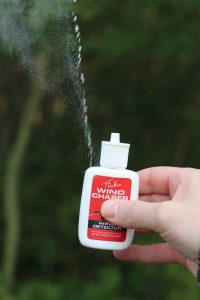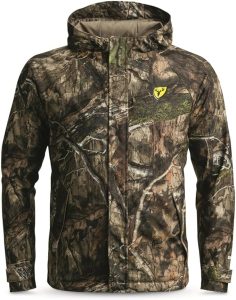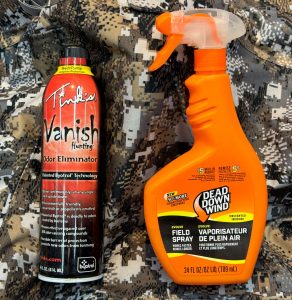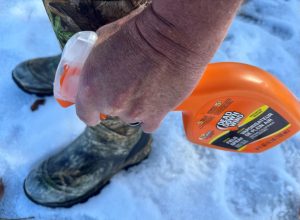Why Scent Control is Essential
Deer, and other game, rely on their sense of smell to detect danger. Fooling their nose is a critical part of the hunting equation.
As the late November sun beat down, I heard the familiar rustling of leaves. Adrenalin pumping, I knew this could only mean one thing. Fifty yards off to my left, a deer was meandering through the woods. Moments later a big bodied, dark antlered buck emerged from a tangle of twisted branches. It was a handsome four-by-four mule deer. Just a few more steps and I would have my shot opportunity.
Arrow already nocked, I carefully reached for my bow. Locked my release onto my D-loop, and waited. The cool morning air carried the aromas of late fall. Unfortunately, though, other scents were about to create a problem for me. The buck looked like he was coming in on a string. He even hit the main deer trail and began to walk directly toward me. Unfortunately, at just 18 yards, while he was facing directly toward me he stopped, put his not to the ground, sniffed, and backed away. My heart sank … did I just lose my opportunity?
Swirling air currents might have worked against me, but I don’t think so. I’d walked on that trail the day before and conditions were dry. Scent from my boots may very well have been lingering. Regardless of the details, this buck didn’t like what he smelled, so he turned and angled off in another direction. Fortunately, he gave me a further quartering away opportunity through a small window. A fleeting opportunity, as soon as he walked behind a tree, I drew, anchored, aimed, and waited. When he hit that narrow opening, at 37 yards, I released. The arrow passed through his chest, he bucked and raced away. After waiting the proverbial 45-minutes, I climbed down and found him at the end of the blood trail. This one worked out, but every deer hunter knows that human scent can ruin a hunt in a hurry. So important is scent-control, that an entire sector of the hunting industry focuses on managing human odor and even attracting game with certain scents.
Is Scent Control Necessary
Bottom line – if you want to see consistent success as a deer hunter, the answer is yes. Human odor is offensive to deer and, in fact, most game animals. As hunters, its impossible to eliminate our foul smell completely, but we can certainly take measures to minimize it. Knowing this, our biggest asset, if used properly, is learning how to use the wind in our favor. Undeniably the most important step we should always take, we we can also use scent-eliminating sprays, scent-blocking clothing, scent-eliminating soaps when we wash our clothing, blinds, cover-up scents, and footwear to contain or minimize much of our bad odor.
Arguably one of the hottest topics discussed among bow hunters in particular, scent-control is a big deal. Archery hunting is a close encounter game and we simply can’t enjoy success if we can’t get close to our target animals. Contemporary marketing has convinced many of us that commercial scents and scent eliminators are the ticket. While I use, and believe in, a select few of these products, I can say with great confidence that after 30-plus years of bow hunting and a two decades of owning and operating a trophy whitetail outfitting and guiding operation, some of these scents do indeed deliver as they promise. Even still, if we fail to hunt smart, no amount of technology or cover-up scent can close the deal for us. In the end, you still have to understand when, where and how you risk depositing or distributing scent go into and exiting your hunting locations, and how your human odor is distributed even while you are sitting on stand. In other words, it’s important to acknowledge breezes, winds, and even thermals when there is next to no air movement. Acknowledging when, where, and how thermals carry scent along with reading and interpreting prevailing winds will help you get close to game.
Use the Wind

Wind can be capricious. It can come up in a hurry and it can dissipate just as fast. It can gust, swirl, waft, or blow with intensity. Erratic or swirling winds create the worst conditions for any hunter. The unpredictable nature of wind carries scent to and fro at random. Every hunter knows that erratic or swirling winds, or even light breezes, can be the kiss of death. Watch deer move through the woods when its windy, and it’s easy to tell they’re on edge. When its calm, they can hear and smell potential danger much better, and they know it.
Some hunters concerned with scent control, prefer calm conditions, but my own preference for most stand, or even still-hunting, is usually a slight or even stiff, but constant, breeze. Depending on the species I’m hunting, wind can be good or bad. Spot and stalk hunting for instance is usually more successful when a consistent wind allows the hunter to work into or across it. Regardless of its mood on any given day, there is no arguing that wind carries scent.
One of the most valuable tools I carry is a wind indicator bottle containing odorless talc powder. Before doing any stalk or even walking into a stand location, I give the bottle a squeeze to see how the air currents are moving. If you don’t use one already, you should.
Clothing & Scent-Blocking Fabrics

Odor concealment is equally important. Some of the best gear I’ve discovered in recent years is made by ScentBlocker. Several companies proclaim scent-blocking or masking qualities and, given the outcome of a court case several years ago, evidence has shown that the company’s claim about their ability to block human odor are substantiated. Over the years, I’ve become a big fan of this stuff. Made with activated carbon and antimicrobial technology to aid in odor control, this technology is unreal and yes, I’m a believer – I’ve seen it work firsthand.
Along with scent-blocking clothing are other related fabrics used extensively in some of today’s portable commercial blinds. One of the best odor-controlling blinds I discovered a few years back, is Ameristep’s Caretaker ground blind. Utilizing scent-control technology as well, it effectively conceals and helps block undesirable odors from possible detection by game.
Cover-Up Scents

Observing the trend in cover-up scents over the last few decades, there’s been a huge influx of commercial products. When the first commercial cover-up scents were made available, it was common to see things like earth, rabbit, and fox scents. Today the roster has expanded to include things like cedar, pine, coon, acorn and more. Attractants like estrus and urine scents have become so popular today that many different brands can be found on the shelves of your favorite hunting store. And, while I’m sure many work as they say, I’ve come to rely on only a select few. Having experimented with lots of different brands over the years, I now typically use four main brands including H.S. Scents, Tink’s, Scent Shield, and Dead Downwind products almost exclusively. Sometimes I’ll hang canisters with cotton or tissue saturated with these estrus or urine scents near where I’m hunting. Other times I’ll anoint the ground close to my stands, place attractants in existing or mock scrapes, and sometimes I’ll put a few drops on the sleeve of my jacket or on my pants.
In my experience, cover-up scents work but circumstantially. In my view a smell is a smell. I tend think no odor is better than introducing an additional odor. Most bow hunters have their own opinion on this matter, but for me scent-eliminating sprays are a better bet for controlling odor. They are probably the most universally used and most effective cover-up products on the market today.
Using Footwear to Control Scent
As obsessive as many bow hunters are about scent, it is surprising how many of us forget about our feet. Feet sweat and smell. Think about it; we wear our boots or shoes everywhere and we step in all kinds of stuff. From washrooms to gas stations, restaurants, and more; everywhere we step, we pick up manmade odors that are highly offensive to critters. Aside from spraying down with odor-eliminating products, we can take practical steps to minimize foreign odors. Granted, we’ll never get rid of them completely but we can take simple steps. When possible, wear a rubber boot. Rubber tends to shed odors more than fabrics or even leather. In the early-to-mid-season, I like to where a knee-high rubber boot. Something like a Muck Boot or Lacrosse Alpha Burly can be good choices when it comes to rubberized footwear.

But just wearing that footwear isn’t enough. Savvy bow hunters take extra care to wear street shoes or boots in their vehicle and even up until they arrive at the location they’ll be hunting. For years, I stored and transported my hunting clothes and boots in plastic bags or Rubbermaid containers. I’ve even gone so far as to place spruce limbs in with them to ensure as natural a smell as possible.
Check out this story on Best Hunting Boots
Attractants as Scent Control
We can’t talk about scent-control, without at least mentioning attractants. Aside from masking our human odor, we can also use different scents to attract to, and hold deer in an area. One of the best tools the author has discovered to date are the Hodag products. This Hodag hemp scent rope, hung 18 yards from the author’s stand, is soaked with doe estrus scent. Aside from attracting both bucks and does, hung at the right height, they love to play with it. This serves to preoccupy them for a while, giving the hunter a desirable shot opportunity.
Insert Hodag MP4
Other Stuff about Scent Control
In the end, bow hunting demands that we consider a variety of variables to help us get close to game. Remember, your face, hands, and even your breath retains odor. I’ve seen odor-eliminating facemasks, gloves, and even chewing gum that is said to obliterate foul breath. Just how far we take the scent control thing is up to each bow hunter, but one thing is certain; if animals catch our scent, its game over
Per our affiliate disclosure, we may earn revenue from the products available on this page. To learn more about how we test gear, click here.



